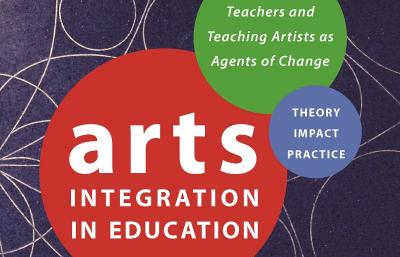Paul Collard finds the book about teaching artists as agents of change comprehensive and useful.

Arts Integration in Education is a comprehensive and useful book.
In this context, ‘arts integration’ is taken to mean both education through the arts and education in the arts in formal education. The book describes a wide range of practices using a rich diversity of art forms.
Those who will find the book most valuable will be artists or classroom teachers seeking to develop and enhance their practice, while those managing artist/teacher programmes will find it useful in guiding the development of their practitioners.
There is clearly a bias towards a constructivist view of learning, but this is appropriate to the subject matter
The first section of this three-sectioned book looks at the theoretical foundations of arts integration. It is important to understand the learning theories on which these practices are built, because it improves their impact and strengthens evaluation and assessment. The theories outlined in the book will be familiar to many working in the field, but the summaries are concise and readable – which is often more than can be said of the originals.
There is clearly a bias towards a constructivist view of learning, but this is appropriate to the subject matter and it is good to see that more recent work on the neuropsychological foundations of learning is given space. Much is being achieved in neuroscience to help us understand why arts integration works and how to sharpen the practice to maximise impact.
A common complaint from teachers is that training and advice given to them to support the integration of the arts in schools focuses too much on theory and there is insufficient practical guidance. These teachers will be delighted with the third section of this book, which focusses on practice and provides informative and detailed descriptions of activities that teachers can use or adapt in their own classrooms.
The examples used cover a wide range of art forms. By providing clear and precise descriptions, this book makes activities more accessible and will encourage teachers to experiment with art forms outside their comfort zones. The section on ‘Dancing with the Brain’ for instance provides both the ‘ingredients’ of dance activities that most people could manage, and some ‘recipes’ that combine these ingredients into a more extensive lesson plan.
The subtitle of the book is ‘Teachers and Teaching Artists as Agents of Change’. Key to this becoming a reality is teacher training and this is the focus of the second section of the book. However, the purpose of this section is less clear. While rooting one’s practice in theory is important and detailed descriptions of practice are valuable, the second section feels more like polemic than an informative guide to practice.
If it is aimed at those designing and managing teacher training, they would already know the arguments in favour of a greater focus on arts integration techniques. If they were not persuaded before, then the arguments here aren't sufficiently fresh to lead to a change of mind and there is insufficient detail to help them design appropriate curricula. However, for a practitioner embarking on training, it might help them identify appropriate themes to search for.
There were a couple of omissions from the book. Firstly, apart from the somewhat random inclusion of an article on Charles University in Prague, the book draws all its examples from North America. For a book aimed at an American market, that is logical. However, for an audience from Europe or beyond, this is not re-assuring. North America is culturally and educationally very different and while the work highlighted is strong, teachers and artists outside North America need some reassurance that these practices will work with their pupils. I believe it will, but examples need to be provided.
Secondly, there is no real discussion about evidence and evaluation. The book acknowledges that arts integration often produces additional and different educational outcomes from those traditionally valued in education systems, and describes what some of those might be. But evidencing those outcomes is a central part of the practice, because it is by evaluating the impact of your work that your practice gets stronger. This needs to be built into the practice and there is little practical guidance as to how to do this.
Paul Collard is Chief Executive of Creativity, Culture and Education.
www.creativitycultureeducation.org



